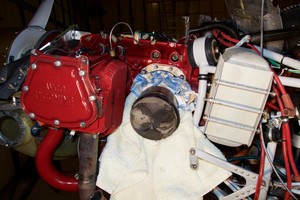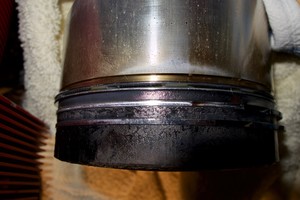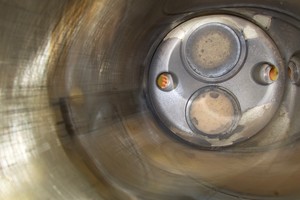 I finished removing all the stuff around the #4 cylinder yesterday, and today Lee, a coworker, helped me remove the cylinder. It came off quite easily, then we could look inside and also inspect the piston.(
I finished removing all the stuff around the #4 cylinder yesterday, and today Lee, a coworker, helped me remove the cylinder. It came off quite easily, then we could look inside and also inspect the piston.(
 The piston has a stuck #2 compression ring, and signs of significant blow by. I’ll discuss the cylinder and piston condition with an overhaul shop to determine what I need to do.
The piston has a stuck #2 compression ring, and signs of significant blow by. I’ll discuss the cylinder and piston condition with an overhaul shop to determine what I need to do.
 The wide, worn area on the cylinder wall that was observed in the borescope was quite noticeable with the naked eye. But it was not very deep, only on the order of 0.001", or so. The transition between the worn and unworn areas is very smooth. I do not believe that this small amount of wear explains the metal found in the oil filter. Drat :(
The wide, worn area on the cylinder wall that was observed in the borescope was quite noticeable with the naked eye. But it was not very deep, only on the order of 0.001", or so. The transition between the worn and unworn areas is very smooth. I do not believe that this small amount of wear explains the metal found in the oil filter. Drat :(
Meanwhile, I still need to figure out where the metal in the oil is coming from. The next step is to inspect the cam shaft. I had thought it was necessary to remove cylinders to allow the pushrods and hydraulic tappets to be removed, allowing the cam lobes to be seen. But today, following the cylinder removal steps from the Lycoming Overhaul Manual, I noted that one should be able to inspect the cam without removing cylinders, by removing the valve rockers, pulling out the pushrods, removing the pushrod tubes, then pulling out the tappets. But, there is some sort of magic trick to pulling out the tappets. The overhaul manual describes how to do it, but we were not successful today. I need to get an Aircraft Maintenance Engineer over to help me out.